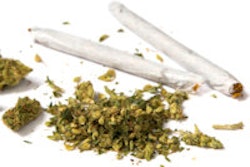
Marijuana smokers have an elevated risk of oropharyngeal cancer but a reduced risk of oral tongue cancer, according to a new study in Cancer Epidemiology Biomarkers & Prevention (December 18, 2013). But the study authors noted that oral human papillomavirus (HPV) infection could explain the increased risk of oropharyngeal cancer among marijuana smokers.
Head and neck squamous cell carcinomas (HNSCC), which include cancers of the oral cavity, oropharynx, and larynx, are the sixth most common cancers worldwide, with 633,000 cases diagnosed annually, resulting in 355,000 deaths. In addition to traditional risk factors, such as tobacco and alcohol use, HPV infection has recently been established as a major etiologic factor for a subset of HNSCCs -- cancers of the oropharynx that include the base of the tongue, tonsil, and other parts of the pharynx.
Although overall U.S. cancer death rates continue to decline, incidence rates for HPV-related oropharyngeal cancers are increasing, according to a 2013 annual report on the status of cancer in the U.S. (Journal of the National Cancer Institute, February 6, 2013, Vol. 105:3, pp. 175-201).
The incidence of a majority of head and neck cancer subsets (cancers of the lip, oral cavity, larynx, hypopharynx, and nasopharynx) has declined significantly during the past two decades in the U.S. and other developed countries, largely because of declines in cigarette smoking. In contrast to this overall pattern, the incidence of oropharyngeal and oral tongue cancers has significantly increased during the same period, especially among people younger than age 45.
The current study by an international team of researchers investigated the association of marijuana use with the risk of oropharyngeal and oral tongue cancers in a large pooled analysis of nine case-control studies that were part of the International Head and Neck Cancer Epidemiology (INHANCE) consortium.
Three out of the nine studies were hospital-based (Baltimore, Houston, and Latin America). Seven studies matched controls to cases (Boston, Houston, Latin America, North Carolina, Seattle, Seattle-LEO, and Tampa), and two studies performed individual matching (Baltimore and Los Angeles). The studies included data on lifetime marijuana use from cases and controls, including duration of use and frequency of use. The studies used interviewer or self-administered questionnaires.
The study analyzed people with oropharyngeal cancer, including tumors of the oropharynx, base of tongue, tonsils, soft palate, and uvula. Oral tongue cancer cases included tumors of the dorsal surface, border, and ventral surface of the tongue.
Marijuana
Marijuana use has significantly increased among people born after 1950, raising the hypothesis of a role of marijuana use as a risk factor for oropharyngeal and oral tongue cancer development. A recent study reported that marijuana use was strongly associated with increased risk of HPV-positive oropharyngeal cancer. Conversely, a study of HNSCC demonstrated an inverse association of marijuana use on cancers of the oral cavity, the researchers noted.
“The differing associations of marijuana use ... provides some epidemiologic support for the biologic effect of cannabinoids.”
The major bioactive cannabinoid compound found in marijuana smoke, tetrahydrocannabinol (THC), has been shown to have both pro- and anticarcinogenic capabilities. As a result, this cannabinoid has been investigated as a potential therapeutic agent in the treatment of glioma, breast, and prostate cancers, the study authors noted.
The effects of THC and other cannabinoids on modulating tumorigenesis may be cell- and tissue-specific based on receptor expression profiles. This may help explain the differing associations of marijuana smoke with oropharyngeal and oral tongue cancers, the researchers said.
Tobacco and alcohol use is a recognized risk factor for both oropharyngeal and oral tongue cancers and is strongly correlated with marijuana use, they noted.
HPV
While increases in oropharyngeal cancer incidence are attributed to increased infection of oral HPV through changes in sexual behavior among young people, the reasons underlying the growing rates of oral tongue cancer are largely unknown. Notably, HPV infection is not currently believed to play a major role in the etiology of oral tongue cancers.
Differential exposure to HPV infection among marijuana smokers as compared with nonsmokers could be one source of potential confounding to explain the association of marijuana use with oropharyngeal cancer, as marijuana users engage more frequently in risky sexual behaviors leading to higher rates of sexually transmitted infections, the researchers noted.
The association of marijuana use appeared to be specific for those oropharyngeal cancers most likely to be HPV-associated: nonsmoker/nondrinkers, and those with tonsil or base of tongue sites.
Because sexual behaviors (which increase the likelihood of HPV exposure) and marijuana use could be highly correlated, the researchers conducted two separate analyses to evaluate the potential confounding effects of HPV on the observed associations of marijuana use with risk of oropharyngeal cancer. These analyses used external information on the association of marijuana use with oral HPV prevalence the association of current marijuana use and oral HPV infection (odds ratio [OR], 2.87; 95% confidence interval [CI], 1.85-4.46), and the association of oral HPV infection with oropharyngeal cancer risk (OR, 12.3; 95% CI, 5.4-26.4) to calculate a bias factor.
"These data suggest that the positive association of marijuana use and oropharyngeal cancer may be dependent on exposure to HPV," the researchers noted.
Given that a very small fraction of oral cavity cancers are attributed to HPV, it is not surprising that marijuana use remained strongly inversely associated with oral tongue cancer even after adjustment for HPV, the study authors found. The inverse association appeared to be strongest among those younger than age 50, who also have the greatest observed per year increases in oral tongue cancer incidence.
Results
Marijuana use and oropharyngeal cancer
The study included 1,921 oropharyngeal cancer cases, with the majority from Houston (20.3%), Latin America (19.9%), North Carolina (17.9%), and Boston (11.9%). There were 7,639 control cases.
Compared with controls, oropharyngeal cancer cases were more likely to be male (80.4% versus 69.2%) and white non-Hispanic (69.5% versus 65.1%). Oropharyngeal cancer cases were more likely than controls to have used tobacco products (79.7% versus 62.1%) or alcohol (87.7% versus 74.4%). Oropharyngeal cancer cases were more likely than controls to report more than 50 years of cigarette smoking (24.2% versus 10.9%) and more than 60 years of alcohol use (46.3% versus 22.9%).
Some 21% of the patients with oropharyngeal cancer had smoked marijuana, compared with 15% of controls. After adjusting for demographic factors, tobacco, and alcohol use, the risk of oropharyngeal cancer was significantly elevated among marijuana users (OR, 1.24; 95% CI, 1.06-1.47). Marijuana use remained associated with an elevated risk of oropharyngeal cancer among those who never smoked or drank alcohol.
The researchers noted a significant interaction between those who had used marijuana and HPV16 L1 antibody status. Among people who were seronegative for HPV16 L1 antibodies, those who had used marijuana were associated with a significantly decreased risk of oropharyngeal cancer (OR, 0.54; 95% CI, 0.34-0.85). In contrast, among HPV16 seropositive individuals, marijuana use was positively, but not significantly, associated with oropharyngeal cancer. The results indicate that confounding by oral HPV infection could potentially explain the observed association of marijuana use with oropharyngeal cancer risk (OR, 0.99; 95% CI, 0.71-1.25).
Marijuana use and oral tongue cancer
The analysis included 356 oral tongue cancer cases from five studies, with the majority from Houston (31.1%) and Seattle (25.9%). Compared with controls, oral tongue cancer cases were more likely to be female (34.6% versus 26.1%), white non-Hispanic (77.5% versus 56.0%), and have some college education (30.4% versus 21.3%) and slightly younger (55 versus 57 years). Oral tongue cancer cases were more likely to have used tobacco (73.9% versus 65.2%) or alcohol (81.7% versus 75.7%). Finally, oral tongue cancer patients were more likely than controls to report more than 50 years of cigarette smoking (23.9% versus 11.8%) and more than 60 years of alcohol use (35.9.3% versus 28.2%).
Marijuana use was reported among 7% of the oral tongue cancer cases, compared with 10% of controls. The risk of oral tongue cancer was significantly reduced (i.e., was more protective) among marijuana users (OR, 0.47; 95% CI, 0.29-0.75). Similarly, the risk of oral tongue cancer was significantly reduced among those with higher frequency of marijuana use and longer duration of marijuana use.
"We found evidence of a possible positive association of marijuana use with oropharyngeal cancer and a negative association with oral tongue cancer," the researchers wrote.
Therefore, this association may reflect a true inverse association of marijuana use on oral tongue cancer, they concluded.
"The differing associations of marijuana use on oropharyngeal and oral tongue cancers observed in this study provides some epidemiologic support for the biologic effect of cannabinoids as both a pro- and anticarcinogenic agent," the study authors concluded. "However, given the strong association of HPV on orpoharyngeal cancer not measured in this study, the modest attenuated effect of marijuana on these cancers may well be explained by confounding by HPV."



















